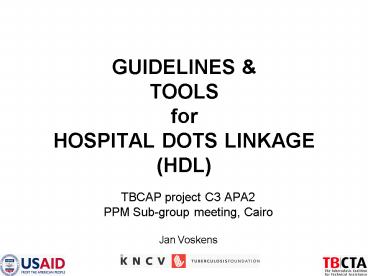GUIDELINES - PowerPoint PPT Presentation
1 / 21
Title:
GUIDELINES
Description:
ISTC endorsed and implemented by public and private hospital providers ... Create hospital task force or DOTS committee ... Establish Hospital DOTS Unit (DOTS ... – PowerPoint PPT presentation
Number of Views:181
Avg rating:3.0/5.0
Title: GUIDELINES
1
GUIDELINES TOOLS for HOSPITAL DOTS
LINKAGE(HDL)
- TBCAP project C3 APA2
- PPM Sub-group meeting, Cairo
- Jan Voskens
2
(No Transcript)
3
Challenges to DOTS in hospitals
- Inadequate clinical management practices
- no standardized protocols for diagnosis and
treatment of TB - poor case holding and high rates of default
- lack of resources and linkages
- user fees
- multiple services TB suspects and TB patients
identified in different units - Risk for amplification of MDR !!
4
Definition Hospital DOTS Linkage HDL
- building a network between public and private
clinical care facilities, (including primary,
secondary and tertiary hospitals, academic
hospitals and charity/ NGO hospitals ) - and the national DOTS program
5
Overall objectives
- Ensure access to quality DOTS services for TB
patients seeking care within the hospital sector
based on International Standards of Tuberculosis
Care (ISTC). - Enable hospitals (public and private,
governmental and non-governmental) to implement
TB control activities that are linked to the NTP
6
Specific objectives
- ISTC endorsed and implemented by public and
private hospital providers - Decreased diagnostic delays and cost savings to
patients - Effective referral mechanism established
- Improved monitoring of treatment and treatment
outcomes for patients diagnosed in hospitals - Improved hospital laboratory quality assurance
- Enhanced surveillance to measure performance
7
HDL Framework
8
Steps for HDL
- Planning
- Implement the external network
- Implement the internal network
- Monitoring and evaluation
9
I. role of the central level
- determine overall policy direction (i.e. national
guidelines and standards) - formulate regulatory frameworks (certification)
- Steps
- establish coordination of stakeholders public-,
private, NGO, medical schools, professional
societies etc - build commitment among decision makers
- develop implementation plan including
- human resource development
- enablers
- monitoring and evaluation
- mobilize resources
- monitor and evaluate
10
enablers
- Free anti-TB medications
- Training and in-service updates for staffs
- Commodities supplied surveillance, IEC
materials, diagnostic supplies and equipment - Logistical support for laboratory EQA network
- Corporate social responsibility to participate in
NTP - Certification and accreditation
11
II. Steps to build HDLexternal Network
- Advocate and mobilize resources
- Establish local coordinating body for HDL
- Define Terms of Reference for interagency
collaborations (MoU) - Carry out baseline assessment of facilities
- Develop implementation plan including
- HRD
- Establishing referral system
- Supervision and problem solving support
12
(No Transcript)
13
Referral system for patients diagnosed in
hospitals
- Develop SOP for patient referral
- Appoint referral coordinator
- implement tools
- Patient referral and Referral feedback forms
- Patient referral register/log kept by referral
coordinator - Default tracing form and Default tracing
register/log - Telephone directory of surrounding health
facilities
14
Generic referral mechanism
Notification of referral
Feed back of information
Referral register
Referral Coordinator
Phone directory
SMS, phone
Receiving Health facility B
Referring hospital A
15
Indicators
- Confirmed sputum diagnosis rate
- No. pts. diagnosed in hospital with smear
confirmation X 100 - No. of patients diagnosed by
hospital - Successful referral rate
- No. of patients received at DOTS center X
100 - No. of patients referred by hospitals
- Successful referral tracing rate
- No. of patients retrieved for
treatment X 100 - No. of patients that dropped out after
referral - Other useful indicators
- Treatment outcomes of referred patients (compared
to not referred pts) - Referral coordinator appointed and in place
- Percentage of hospitals implementing SOP for
patient referral - Availability of telephone directory of facilities
in cluster area (province, district)
16
III. Steps to build HDL Internal Network (a)
- Baseline assessment and planning of Internal
Network - Assess existing hospital practices and give
feedback - Development of a specified HDL task mix
- hospital implementation plan
- Sensitization and advocacy
- Create hospital task force or DOTS committee
- hospital directive and/or district or local
NTP-hospital MOU - Establish Hospital DOTS Unit (DOTS executive room)
17
Internal network
18
Steps to build HDL Internal Network (b)
- Define SOP for
- TB case management (diagnosis / treatment)
- Patient referral
- Internal (within facility)
- External (to local TB treatment centers)
- Develop HRD plan (based on selected task mix and
SOP) - Integrate hospital laboratory into the EQA
network of the NTP - Ensure proper surveillance and supervision
19
Public health functions of options 3 and 4 are
variable and are normally context specific
20
Scaling up
- Phased wise expansion
- Supervision monitor hospital performance
continuously - to assure
- QUALITY !!!
21
- Thank you!
- Your comments and inputs on this draft are most
welcome































